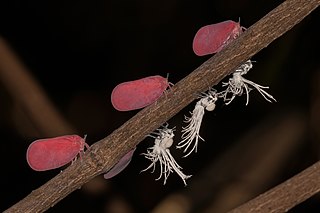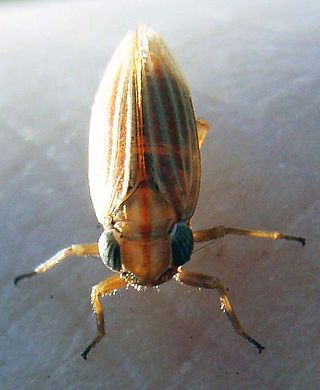
Ricaniidae is a family of planthopper insects, containing over 400 species worldwide. The highest diversity is in tropical Africa and Asia and in Australia, with a few species occurring in the Palearctic and Neotropical realms. It is one of the smaller families in the planthopper superfamily Fulgoroidea.

Flatidae are a family of fulgoroid planthoppers. They are cosmopolitan in distribution and are distinguished from others in the superfamily by a combination of characters. Like all other planthoppers, they suck phloem sap of plants. Some species are known to communicate with vibrations through the plant stems. Communication may be with mates, or with ants that tend the nymphs, protecting them and gathering honeydew secretions. Adults of some species have brightly coloured forewings which are tougher and known as tegmina unlike the membranous hindwings which are used for flight. Although a few can be identified by their coloration, most species requires dissection and examination under a microscope with access to literature on already described species.

Issidae is a family of planthoppers described by Spinola in 1839, belonging to the order Hemiptera, suborder Auchenorrhyncha superfamily Fulgoroidea.

Issus is a genus of planthoppers belonging to the family Issidae of infraorder Fulgoromorpha of suborder Auchenorrhyncha of order Hemiptera. Like most members of the order Hemiptera they live on phloem sap that they extract with their piercing, sucking mouth parts.

Nogodinidae is a family of planthoppers. They have membranous wings with delicate venation and can be confused with members of other Fulgoroid families such as the Issidae and Tropiduchidae. Some authors treat it as a subfamily of the Issidae.

Caliscelidae is a family of planthoppers, sap-sucking insects that belong to the order Hemiptera, suborder Auchenorrhyncha and superfamily Fulgoroidea. They are somewhat anomalous and have often been included within the family Issidae. Studies made in 2013 of the phylogeny of the Issidae and other groups using molecular techniques support the treatment of the group as a separate family. Sexual dimorphism can be marked. Some members of the family are called piglet bugs due to the shape of their snout. A particularly aberrant genus described in 2011 from India, Formiscurra, has males that resemble ants.

Gergithus is a genus of tropical Asian planthoppers in the family Issidae, erected by Carl Stål in 1870. Like all planthoppers, adults feed on plant sap and are capable of escaping by leaping. The genus like other members in the tribe appears somewhat rounded and beetle-like, in some cases, with a mimetic resemblance to ladybird beetles. Species are mostly distributed in the Indomalayan Realm.

Danepteryx is a genus of tropiduchid planthoppers in the family Tropiduchidae. There are about 6 described species in Danepteryx.

Thionia is a genus of planthoppers in the family Issidae. There are at least 60 described species in Thionia. However, several genera have been split off from Thionia reducing the number of species.

Tropiduchinae is a subfamily of tropiduchid planthoppers in the family Tropiduchidae.

Agalmatium is a genus of planthoppers belonging to the family Issidae, subfamily Issinae.

Acanaloniidae is a family of planthoppers. It is sometimes treated as a subfamily of Issidae.

The Hysteropterinae are a subfamily of bugs in the family Issidae, based on the type genus Hysteropterum. Species in 59 genera have been recorded in Europe, Africa, and Asia. One species, Agalmatium bilobum, is now also found as an invasive species in the United States, especially in California.

The Flatinae are a subfamily of planthoppers, erected by Maximilian Spinola in 1839. Genera have been recorded from all continents except Antarctica: especially in tropical and subtropical regions.
Amnisa is a genus of issid planthopper in the family Issidae and are native to Brazil.
Paranipeus is a genus of issid planthopper containing one species, Paranipeus latipes, native to Brazil.

Thabena is a genus of planthoppers in the family Issidae. There are about 15 described species in Thabena, found in southeast and temperate Asia.

Picumna is a genus of planthopper in the family Issidae. They can be found in the Southwestern United States and Central America. Picumna species are often confused with Thionia species, but can be differentiated as Picumna have four spines on their hind tibia, whereas Thionia have fewer.

Notosimus is a genus of planthopper and contains the single species, Notosimus angustipennis. It is found in northern Argentina. It was initially placed in the family Issidae, however analysis of the ovipositor in female specimens led the genus to be moved to Acanaloniidae in 2012.

The Nogodininae are a sub-family of tropical planthoppers erected by Leopold Melichar in 1898. The recorded distribution is: South America, Africa and the Middle East, South and SE Asia through to Australia.
















